Highlights
What are the main findings?
Recycled carbon fibers retained or exceeded the tensile strength of virgin fibers (up to 1.49 times higher) and showed consistent Young’s modulus, while the interfacial shear strength exhibited only a moderate reduction under moderate plasma power (800–1200 W) and balanced acid concentrations (10–12 M HNO3).
What is the implication of the main finding?
The closed-loop plasma–assisted solvolysis process effectively degraded resin, captured NOₓ byproducts and regenerated acids for reuse, demonstrating an environmentally responsible process for recovering high-performance fibers suitable for structural reuse.
Abstract
The rapid expansion of carbon-fiber-reinforced polymer (CFRP) applications in aerospace, automotive, and energy sectors has intensified concerns over end-of-life waste and the absence of efficient recycling solutions. Plasma-assisted solvolysis has emerged as a promising hybrid approach, combining oxidative chemical treatment with plasma activation to accelerate matrix degradation. In this study, CFRP cylinders (6.4 cm height, 5.5 cm internal, and 6.0 cm external diameter) were processed in a closed-loop plasma solvolysis system under varied operational parameters, including plasma power, plasma gas composition, and nitric acid concentration. The mechanical performance of the recovered carbon fibers was assessed through single-fiber tensile and microbond tests, evaluating both tensile and interfacial properties. In most cases, the recycled fibers retained—or even exceeded—the tensile strength of their virgin counterparts, reaching up to 1.49 times that of the virgin fibers. Young’s modulus, though more variable, ranged from 0.48 to 1.67 times the reference value depending on treatment conditions. Elongation at break generally increased, particularly in the 24K (24,000-filaments) fiber sets, suggesting improved surface ductility. Weibull statistical analysis indicated higher consistency in 3K (3000-filaments) fiber batches compared to 24K, whereas interfacial shear strength was moderately retained across conditions. Overall, balanced plasma and acid conditions enabled efficient fiber recovery with high strength and interfacial performance, validating plasma-assisted solvolysis as a viable route for recovering high-performance fibers suitable for structural reuse, in alignment with circular economy principles.
1. Introduction
Carbon-Fiber-Reinforced Polymers (CFRPs) are extensively employed in aerospace, wind energy, and automotive sectors owing to their outstanding mechanical properties, particularly their high strength-to-weight ratio. Modern aircraft, such as the Boeing 787 and Airbus A350, make extensive use of CFRP components, which constitute more than 50% of their structural mass, thereby enhancing fuel efficiency and enabling lightweight design []. Beyond aerospace, the adoption of CFRP composites in automotive structures and high-pressure storage vessels is rapidly expanding. These materials provide significant weight savings and superior crashworthiness, with energy absorption capacities reaching up to 250 kJ/kg—far exceeding the ~20 kJ/kg typical of steel. Such advantages have driven their increasing use in compressed natural gas (CNG) and hydrogen storage systems, particularly in filament-wound pressure vessels designed for vehicles and industrial transport applications [,].
As high-performance composites gain industrial traction, global market projections forecast growth from USD 27.6 billion in 2024 to USD 56.9 billion by 2034 []. With CFRP waste from the aviation and wind energy sectors expected to surpass 840,000 tons annually by 2050 and European composite waste nearing 683,000 tons per year, the current global recycling capacity of under 100,000 tons highlights a critical gap, prompting regulatory pressure and urgent demand for sustainable end-of-life solutions []. Recent studies have further emphasized the need to align composite recycling with the circular economy and sustainability assessment, particularly in aerospace applications, to support environmentally responsible material recovery [,]. This trend increases the need for efficient end-of-life recycling. Thermoset-based CFRPs, unlike thermoplastics, cannot be remelted due to permanent cross-linking in their resin, posing a challenge to traditional recycling methods [].
Several recycling strategies have been developed over the past decades. Mechanical recycling, which involves shredding or grinding composites into smaller particles, is cost-effective but lowers the fiber quality []. Thermal methods, such as pyrolysis, can recover fibers but involve high infrastructure costs and produce harmful byproducts. Chemical recycling, on the other hand, offers high retention of material properties through effective resin removal using solvent systems []. Among recent advancements, plasma-assisted solvolysis, a hybrid approach combining oxidative chemicals and plasma, has shown promise in degrading matrix material while protecting fiber structure [].
The significance of recycling CFRPs lies not only in addressing environmental challenges but also in the ability to recover fibers with properties suitable for reuse in high-performance applications. Notably, mechanical recycling was evaluated by reinforcing polymer composites with recycled carbon fibers (rCFs). The composites showed 208% higher stiffness and 105% tensile strength []. In addition, a process involving microwave pyrolysis followed by oxidation was used to recover clean carbon fibers, and the rCFs retained tensile strength at 73% relative to virgin carbon fibers (vCFs) []. In a recent study, model composites were recycled three times via pyrolysis and partial oxidation. While the stiffness of the rCFs increased up to 130.9% of that of vCFs, tensile strength decreased progressively with each cycle, retaining only 25% with rapid heating []. However, mechanical recycling faces limitations such as poor interfacial adhesion between rCFs and the new polymer matrix, caused by fiber surface damage and shortening during processing []. Pyrolysis can produce gas and liquid feedstocks; however, char formation negatively impacts the mechanical properties of the fibers [].
Recently, chemical recycling of CFRPs has shown promising advances. A comparative study involving methanesulfonic acid (MSA), acetic acid, and nitric acid found MSA most effective, reducing residual resin to 5%. The rCFs experienced a 27.6% reduction in tensile strength, a 19.2% loss in Young’s modulus, and a 10.5% reduction in elongation at break, indicating moderate mechanical degradation []. Similarly, a one-step oxidative solvolysis method using peracetic acid achieved full resin removal with more than 90% recovery of solvents while preserving the tensile strength of the rCFs []. Additionally, using a special catalyst in a dimethylacetamide solvent enabled nearly complete resin degradation without visible surface damage. However, mechanical evaluation showed that the recycled fibers retained 82.8% of their original strength []. In another environmentally friendly approach, CFRPs were immersed in nitric acid followed by sodium bicarbonate, both at 80 °C. Interfacial shear strength (IFSS) and tensile strength increased by 2.7 and 1.6 times, respectively, while maintaining a comparable elastic modulus []. Furthermore, energy-efficient solvolysis using meta-Chloroperoxybenzoic acid (mCPBA) at 40 °C decomposed resin in 6 h; rCFs retained 93.6% of their strength and showed 26% higher IFSS []. A catalytic method employing a monoethanolamine–potassium hydroxide (MEA–KOH) solvent achieved 99% decomposition. Tensile testing, analyzed using Weibull statistics, showed that tensile strength and modulus were retained at 96% and 95%, respectively []. Recently, rCFs recovered through microwave-assisted chemical recycling retained 98.3% of their original tensile strength, 94.1% of Young’s modulus, and 96.2% of the elongation at break []. A semi-continuous flow process using near- and supercritical water and water/ethanol mixtures demonstrated that the tensile strength of rCFs was statistically comparable to unsized virgin fibers []. Moreover, supercritical solvolysis using n-propanol achieved, despite the elevated temperature, rCFs showing no significant deviation in tensile properties; however, there was a reduction in IFSS []. Additionally, a two-step method employing H2O2 and N,N-dimethylformamide enabled over 90% matrix decomposition, with the recovered fibers retaining up to 97% []. A hybrid approach combining chemical swelling and electrochemical oxidation in dimethyl sulfoxide at ambient conditions achieved resin removal of over 90.3%. The rCFs maintained 93.6% of their tensile strength, while their IFSS improved significantly, reaching 118.76% of the original values []. Further, supercritical 1-propanol with a catalyst improved resin breakdown, while the rCFs retained 95% of their tensile strength at temperatures up to 330 °C, but at 340 °C, strength retention dropped to 88.6%, highlighting the process’s temperature sensitivity []. Superheated steam was used to recycle CFRPs, yielding recycled fibers with lower tensile strength. Tensile modulus was nearly the same, and Weibull analysis showed that strength decreased with longer gauge lengths []. An optimized recovery method using supercritical acetone enabled nearly complete matrix removal. Carbon fibers treated at 300 °C for 60 min retained and even exceeded the tensile strength of vCFs []. Finally, in a preliminary study using water- and acetone-based solvolysis under subcritical and supercritical conditions, resin decomposition reached 90–100%. Equally important, rCFs retained over 70% of their tensile strength and 61% of their Young’s modulus [], consistent with findings from water/ethanol-based solvolysis, where comparable mechanical retention was reported under optimized conditions [].
In the evolving field of solvolysis, assisted techniques such as sonication and plasma treatment have shown promise in enhancing resin removal efficiency under milder conditions. For instance, sonochemical treatment using diluted nitric acid and hydrogen peroxide significantly increased the decomposition rate up to 95%, while preserving the tensile strength of recovered fibers. This approach reduces the need for harsh chemicals and high temperatures or pressures []. Plasma-assisted solvolysis using nitric acid has demonstrated complete epoxy matrix decomposition, independent of composite geometry, without the use of extreme thermal and pressure conditions. Treatment time was reduced to under 180 min, while morphological analyses confirmed clean fiber surfaces. The rCFs retained 70% of their tensile strength, 74% strain at break, and 95% of Young’s modulus, indicating strong structural preservation [,]. This aligns with a study showing that plasma-enhanced nitric acid accelerates matrix dissolution by enhancing oxidation and mass transport, with mass transport remaining the main rate-limiting step [].
Overall, previous studies demonstrate that solvolysis methods—and plasma-assisted solvolysis in particular—can recover carbon fibers with minimal loss of mechanical performance and, in some cases, even enhance properties. The present work evaluates the extent to which the mechanical properties of carbon fibers are preserved after plasma-assisted solvolysis, compared with their virgin counterparts. Multiple CFRP batches were recycled under different plasma-solvolysis conditions, and the recovered fibers were subjected to mechanical characterization. Single-fiber tension tests were conducted to measure tensile strength, Young’s modulus, and elongation at break, while microbond tests were performed to assess the interfacial shear strength (IFSS). Statistical analyses were applied to examine property retention across processing conditions. By investigating how plasma-assisted solvolysis influences fiber mechanics, this study addresses key challenges in CFRP recycling. The present study performs a parametric assessment linking plasma power, acid concentration, and gas composition to the quantitative mechanical retention of carbon fibers. Through detailed tensile, interfacial, and Weibull statistical analyses, it establishes a comprehensive correlation between processing conditions and mechanical reliability of recycled fibers. The results advance understanding of hybrid chemical–plasma recycling processes, supporting the development of circular economy strategies for advanced composites and promoting the sustainable expansion of CFRP applications.
2. Experimental Section
2.1. Materials
The CFRPs examined in this study were sourced from composite cylinders produced by filament winding (Figure 1), a technique widely employed for fabricating cylindrical structures. The cylinders were custom-manufactured by Β&Τ Composites, Florina, Greece, using the filament winding method. Each specimen measured 6.4–6.5 cm in height, with an internal diameter of 5.5 cm and an external diameter of 6.0 cm, yielding a wall thickness of approximately 0.25 cm.
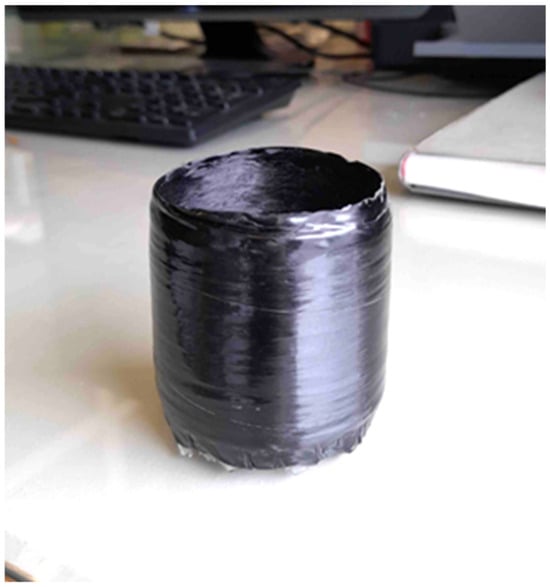
Figure 1.
Custom-manufactured CFRP composite cylinder produced via filament winding.
The reinforcement material used in this study comprised virgin carbon fibers supplied by Fibermax Ltd. (Volos, Greece), specifically the TR30S grade in 3K and 24K tow configurations. The designations 3K and 24K indicate tows containing approximately 3000 and 24,000 individual filaments, respectively, corresponding to small- and large-bundle fiber formats. These fibers are recognized for their high tensile strength and uniform structural quality, making them a standard choice in performance-critical applications. The total fiber mass was 1.80 kg, corresponding to an overall fiber length of approximately 5000 m [].
The polymer matrix employed in this study was the high-performance epoxy laminating system SR 1700, supplied by Sicomin Epoxy Systems (Châteauneuf-les-Martigues, France), a bisphenol-A-based resin widely used in the automotive, naval, and aerospace industries. This resin system is characterized by its high modulus, excellent stiffness, low water absorption after curing, and strong adhesion to various reinforcements, including carbon fibers. The curing process incorporated the SD 2803 and SD 2806 amine hardeners, supplied by the same manufacturer, mixed with the resin at the recommended 100:39 (w/w) ratio. The resulting composite structure demonstrated good mechanical integrity, with a service temperature capability of up to 60–70 °C. The key properties of the resin system, as provided in the technical datasheet, are summarized in Table 1 [].

Table 1.
Tensile properties of the SR 1700 epoxy resin system, as provided by the manufacturer’s technical datasheet.
2.2. The Plasma-Assisted Solvolysis Process
The plasma-assisted solvolysis process consists of five sequential stages: (a) material pre-treatment, (b) solvolysis in a plasma reactor, (c) fiber cleaning, (d) liquid waste regeneration, (e) flue gas scrubbing. Figure 2 illustrates the integrated process flow chart.
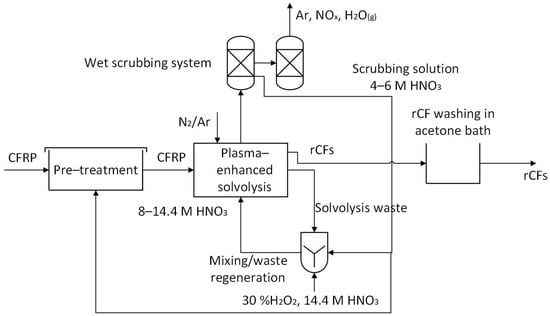
Figure 2.
Plasma-enhanced solvolysis flow chart.
The recycling process begins with pre-treatment, swelling the composite in a low-concentration nitric acid solution, typically 4–6 M. This step enhances the accessibility of the resin matrix, improving its sensitivity to oxidative degradation during the plasma-assisted phase. The pre-treatment is essential for facilitating uniform plasma exposure and efficient resin breakdown.
Following pre-treatment, the composite is transferred to a 2 L glass reactor and is submerged in 1.2 L of a higher-concentration nitric acid solution, about 10–14 M. The reactor is mounted on a stainless-steel baseplate, which serves as the grounded electrode. Four vertically oriented cylindrical electrodes, referred to as plasma heads, are inserted into the solution. Each electrode is surrounded by a glass tube that delivers a controlled flow of inert gases, argon (Ar) and nitrogen (N2), in a fixed 2:0.5 volumetric ratio, forming bubbles within the solution to support plasma generation. The electrodes are powered by an alternating current (AC) generator (IGBT143, Martignoni Elettrotecnica, Milano, Italy) operating at 30 kHz, with a maximum output of 2 kW. Under these conditions, plasma is generated within the liquid medium, initiating oxidative decomposition of the polymer matrix. During treatment, the applied voltage is ~30 kV peak-to-peak and is monitored using a high-voltage 1000:1 passive probe (P6015A, Tektronix, Beaverton, OR, USA). Current flow is ~2–3 A peak-to-peak, and it is measured via the voltage drop across a 47 Ω precision resistor (HS300 47R J ±5%, Arcol) connected between the stainless-steel bottom electrode and ground, using a 100:1 passive voltage probe (Hameg HZ53, Mainhausen, Germany).
Plasma treatment accelerates resin degradation, enabling the release of clean carbon fibers. Throughout the process, solution temperature can reach 110 °C within 60 min due to plasma-induced heating. Real-time monitoring of process voltage, via passive high-voltage probes, ensures consistent control of input power. Upon completion of the plasma treatment, the recovered carbon fibers are mechanically separated from the solution and washed with acetone to remove residual matrix and acid contaminants. Around 1 L of acetone is sufficient for cleaning 1 kg of fibers.
During the solvolysis process, nitrogen oxide (NOx) gases are generated as byproducts. These emissions are directed into a wet scrubbing system, where fraction of the NOx is converted into nitric acid. This recovered solution is then reused in the pre-treatment stage, forming part of a closed-loop chemical cycle. These emissions are directed into a wet scrubbing system of 0.06 M H2O2 and 0.01 M HNO3, where a fraction of the NOx is converted into nitric acid. Specifically, a two-stage wet scrubber is employed, involving 2 × 1.5 L wet scrubbing solutions connected in series. Typically, during operation 0.3–0.4 of emissions are led into the wet scrubber. After 50 h of operation, NOx recovery stabilizes at ~82%, while the concentration of the first-in-series wet scrubbing solution starts plateauing at 5–6 M HNO3. This recovered solution is replaced with fresh scrubbing solution and then reused in the pre-treatment stage, forming part of a closed-loop chemical cycle. In addition, the residual liquid remaining in the reactor undergoes a regeneration process involving the addition of fresh nitric acid, hydrogen peroxide (H2O2), and the scrubber-derived acid. This mixture restores the reactivity of the solution, allowing its reuse for 4 operation cycles before replacing it with fresh HNO3 [].
To systematically assess the recycling performance of carbon fibers, several experiments were conducted by varying the plasma-enhanced solvolysis parameters. First, a one-electrode configuration using pure N2 and 14.4 M HNO3 was tested by increasing the composite mass loaded in the reactor and keeping a constant power input (800 W). In this case, low treatment times (<6 h) for complete resin degradation were achieved. However, high HNO3 losses and thus high NOx emissions were observed. To minimize the environmental impact, a four-plasma-head configuration and N2/Ar mixtures were selected and the effect of solvent concentration, power input, and N2 and Ar flow rate on the materials’ mechanical properties were tested. The adjustment of the parameters was performed considering the generator power, the reactor materials’ properties, and solvent losses. It is wort noting that the reaction time was kept equal to 6 h unless complete resin dissolution was achieved.
Table 2 summarizes the experimental conditions for each sample (Set 1 and Set 2 stand for 3K and 24K virgin fibers, while Set 7 stands for conventional HNO3 solvolysis).

Table 2.
Parameters applied in each plasma-assisted solvolysis test.
2.3. Characterization of Fibers
2.3.1. Single-Fiber Tension Test
Recycled carbon fiber batches obtained from plasma-assisted solvolysis were visually inspected prior to mechanical testing. Figure 3 shows a typical batch, with fibers retaining a linear structure and appearing largely free of visible resin residues. The fibers’ surfaces were further investigated by SEM imaging (JEOL 6300, Zhubei City, Taiwan).
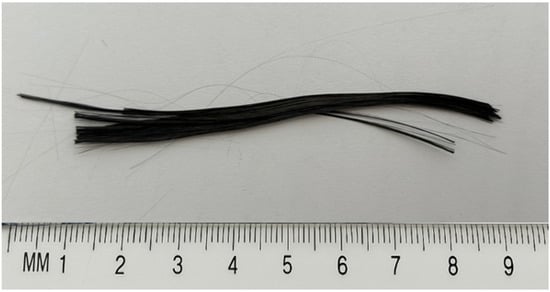
Figure 3.
A typical batch of rCFs after plasma-assisted solvolysis treatment.
The mechanical properties of the recycled carbon fibers were assessed using a Minimat 2000 material tester (Rheometric Scientific, Piscataway, NJ, USA) in accordance with ASTM C1557–14 []. A gauge length of 25 mm and a crosshead speed of 2 mm/min were selected following ASTM C1557–14, which recommends this length for single-fiber tensile testing. Similar parameters have also been adopted in studies on recycled PAN-based carbon fibers obtained from epoxy composites [], confirming the suitability of this range. Preliminary trials at different speeds showed that 2 mm/min provided stable elongation and fracture within 30 s, in accordance with the standard. For sample preparation, individual fibers were carefully mounted on paper frames using a two-part epoxy adhesive applied at both ends. The fibers were aligned carefully to avoid any pre-tension, ensuring reliable test results. The fiber diameter was determined by scanning electron microscopy (the mean of ten random measurements per set) prior to tensile testing. Tensile strength, Young’s modulus, and elongation at break of each fiber were then calculated based on the recorded force and displacement data. These properties were derived using the following equations:
- Tensile strength :
where is the force to failure and is the fiber cross-sectional area at the fracture plane.
- Young’s modulus :
- Elongation at break :
A representative force–displacement curve obtained from the tensile testing is shown in Figure 4, illustrating the raw output from the testing machine used to extract mechanical properties.
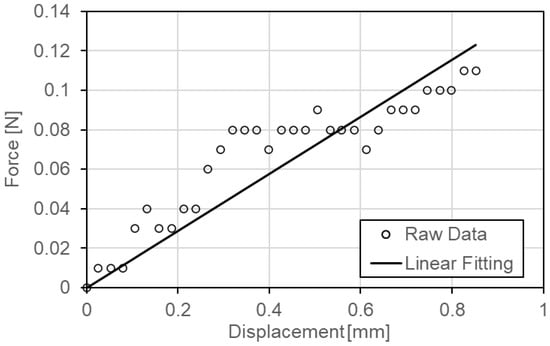
Figure 4.
Representative force–displacement curve of a single-fiber tension test on a recycled carbon fiber.
Data collection focused exclusively on specimens that were fractured within the gauge length, excluding any tests where failure occurred outside this region. Each reported value represents the average from at least 25 valid tests. The instrument was calibrated before each testing series following the manufacturer’s instructions. The installed load beam had a maximum capacity of 200 N, and the tear force limit was 5% of the load beam capacity. The raw force offset was confirmed to remain below this limit and was automatically zeroed via the system software prior to loading each specimen. Prior to calculating the mean values of the mechanical properties, interquartile range (IQR) analysis was employed to remove outliers caused by slipping or grinding problems, providing a statistically robust dataset. This approach identifies values lying outside the range defined by and , where and are the first and third quartiles of the dataset, respectively. Data points outside this range were considered statistical outliers and excluded from the final averages. A summary of tested and accepted fibers after filtering is provided in Appendix B. From these measurements, tensile strength, Young’s modulus, and elongation at break were calculated to evaluate the effect of plasma-assisted solvolysis on the mechanical performance of the rCFs compared to vCFs. All results are reported as means ± standard deviation in Appendix A.
2.3.2. Microbond Test
To evaluate the fiber–matrix interfacial properties, microbond tests were conducted. For each fiber type, both virgin and recycled, three independent tests were performed, with each test comprising at least 25 single-fiber droplet measurements. The parameters that recorded were fiber diameter, embedded length, droplet area, and maximum debonding force. The droplet area, , was calculated assuming a cylindrical shape using the formula
where is the fiber diameter and is the embedded length of the droplet.
Interfacial shear strength was determined by calculating the slope of the linear fit between the applied force and the embedded droplet area, providing a more reliable metric than maximum load alone. Mean IFSS values were computed for each test to ensure statistical robustness. It is important to note that the microbond test is highly sensitive to the accurate measurement of droplet dimensions and the resin curing conditions, and variability in results often reflects differences in fiber–matrix interactions rather than experimental error. The resin droplets were prepared from Araldite®LY5052 epoxy and Aradur®5052 hardener (Huntsman Advanced Materials, Basel, Switzerland). The resin droplets were deposited within 30 min after mixing to maintain consistent viscosity and embedded lengths of approximately 50–150 µm. Curing was performed at 80 °C for 2 h followed by post-curing at 120 °C for 1 h, ensuring reproducible polymerization across all samples. Force and strain data were collected at a sampling frequency of 50 Hz using a FIBRObond microdroplet tester (Fibrobotics, Tampere, Finland) []. Figure 5 presents an optical micrograph showing an ellipsoidal resin droplet formed around an embedded fiber during sample preparation.
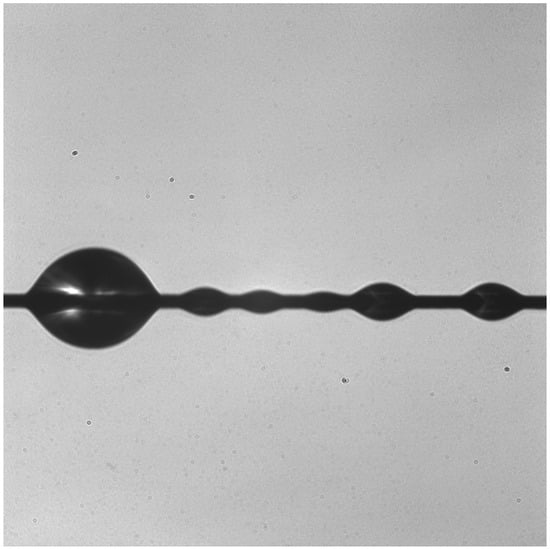
Figure 5.
Optical micrograph of a resin droplet formed around a carbon fiber, showing the characteristic ellipsoidal shape and uniform fiber alignment achieved during sample preparation.
2.4. Preliminary Statistical Analysis
After calculating the mechanical properties for each set of rCFs, a statistical evaluation was performed using a two-tailed t-test. This method was selected to determine whether the observed differences in properties between recycled and virgin fibers were statistically significant, or simply due to random variation. The t-test is a well-established statistical tool that helps assess whether the difference between two groups is likely due to actual changes, from the recycling process. Each rCF batch was compared to the virgin fiber reference group, and the corresponding p-values were computed. A p-value less than 0.05 was considered statistically significant, indicating that the recycling process had a measurable effect on the fibers [].
Due to variability in surface condition, mainly from uneven resin removal during solvolysis, rCFs often show significant scatter in tensile strength measurements. Residual epoxy clusters can act as micro-defects, subtly alter fiber geometry, and cause localized stress concentrations under load. These irregularities affect how individual fibers deform, leading to performance differences within the same batch.
To interpret this scatter and assess the reliability of tensile data, a two-parameter Weibull distribution was applied, commonly used for brittle materials where failure is governed by surface flaws. The failure probability for a given stress and gauge length , relative to a reference length , is described by the Weibull expression:
Here, is the scale parameter (characteristic strength) at which 63.2% of fibers are expected to fail, and is the shape parameter (Weibull modulus), which indicates strength consistency—a higher value means lower scatter.
To calculate these, tensile strength values for each rCF set were ranked in ascending order. The failure probability for each value was estimated using
where is the total number of samples. A linearized form of the Weibull equation
was used to extract the slope and intercept . This analysis helps quantify how uniformly the recycled fibers perform under tensile stress and offers insight into the presence of defects introduced during the recycling process [,].
3. Results
3.1. rCFs Morphology
Figure 6 illustrates representative SEM images of the recycled fibers for the one-electrode configuration (Figure 6a) and four-electrode configuration (Figure 6b–f). All recycled fibers are resin-free, which indicates that, regardless of reactor configuration and solvolysis parameters, good-quality surfaces can be obtained.
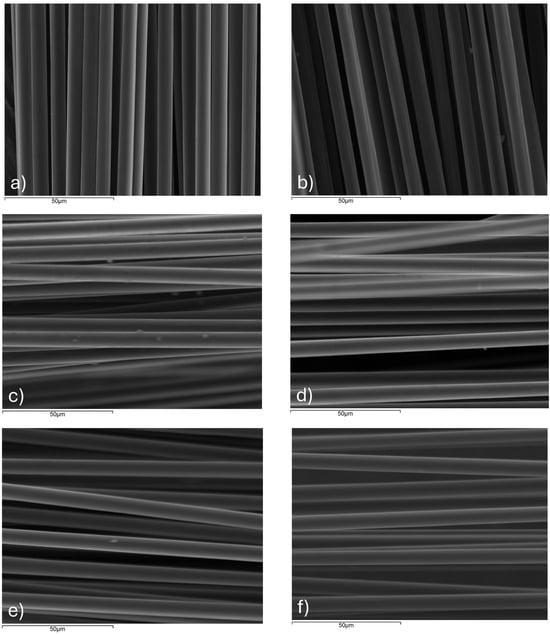
Figure 6.
SEM images of recycled fibers: (a) Set 5 (one-electrode configuration, 800 W, 14.4 M, N2); (b) Set 9 (four-electrode configuration, 1680 W, 12 M, N2/Ar, high flow rates); (c) Set 16 (four-electrode configuration, 1200 W, 12 M, N2/Ar, low flow rates); (d) Set 17 (four-electrode configuration, 1200 W, 12 M, N2/Ar, low flow rates); (e) Set 19 (four-electrode configuration, 800 W, 10 M, N2/Ar, low flow rates) and, (f) Set 21 (four-electrode configuration, 1600 W, 10 M, low flow rates).
3.2. Mechanical Properties of Fibers
To evaluate the effect of plasma-assisted solvolysis on the mechanical performance of rCFs, tensile tests were conducted for each recycled set and compared to their corresponding virgin fiber types (3K and 24K). The results are presented as bar charts for three mechanical properties: tensile strength, Young’s modulus, and elongation at break (Figure 7, Figure 8, Figure 9, Figure 10, Figure 11 and Figure 12). For each property, both mean values and standard deviations are reported.
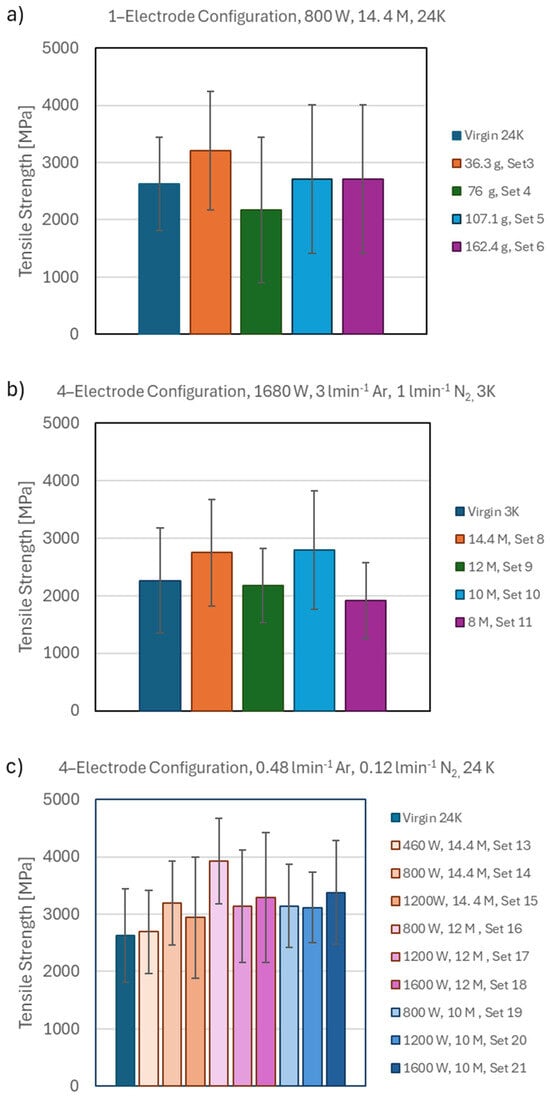
Figure 7.
Recycled fibers’ tensile strength for different process parameters: (a) CRFP mass effect, (b) concentration effect, (c) power–concentration combined effect.

Figure 8.
Recycled fibers’ Young’s modulus for different plasma parameters: (a) CRFP mass effect, (b) concentration effect, (c) power–concentration combined effect.

Figure 9.
Recycled fibers’ elongation at break for different plasma parameters: (a) CRFP mass effect, (b) concentration effect, (c) power–concentration combined effect.
Figure 7 illustrates the tensile strength results for different plasma-enhanced solvolysis parameters. Virgin 3K fibers exhibited an average tensile strength of 2264.33 MPa, while virgin 24K fibers reached 2632.31 MPa. Among the recycled sets, notable reductions were observed in a few cases, particularly in Sets 4, 11, 2, and 9, where the strength decreased significantly compared to the virgin reference. According to the t-test analysis, these sets showed statistically significant differences (p < 0.05), indicating that the recycling conditions affected the fibers. In contrast, several other sets retained their original tensile strength or even exhibited improvements, with Sets 16, 18, and 21 showing the most substantial increases.
The variations in the mechanical properties can be attributed to chemical, thermal, and physical phenomena that take place in the plasma-enhanced solvolysis reactor. Plasma-enhanced solvolysis takes advantage of conventional HNO3 solvolysis and plasma chemistry. Plasma enhances the production of reactive species such as •OH, •OH2, •O, and •NO2 that promote resin degradation and at the same time can chemically modify the fiber surface. Moreover, plasma-induced heating facilitates resin dissolution, but the extended exposure of the fibers to high temperatures can reduce their mechanical strength, as reported by Kim et al. []. Thus, solvent concentration and power input, which both affect the solvent reactivity and temperature, are expected to play complicated roles in determining mechanical properties.
Figure 7b illustrates the effect of the solvent concentration at constant input power (1680 W). The tensile strength was enhanced when 10 M and 14.4 M solutions were used. The enhancement of the mechanical properties at moderate concentration (10 M) aligns with the literature [], indicating sufficient amount of oxidants to remove the resin without damaging the fibers. However, the enhancement of tensile strength at 14.4 M seems to contradict the literature, which states that high HNO3 concentration (Rijo et al.) and high solvent temperature (Kim et al.) degrade material properties. In our case the low treatment time (4 h was enough to completely degrade the resin) suppresses the extreme oxidation phenomena and the damages due to extended heating. Figure 7c illustrates the combined effect of solvent concentration and power input (Sets 13–21) for low gas flow rates. In all cases the fibers exhibit improved tensile strength compared to the virgin fibers. This enhancement is more pronounced when using 10–12 M solutions and low (800 W) or intermediate input power (1200 W). Operating at low input power and low flow rates limits both the solvent temperature and the extreme shock waves that could also affect the fibers surface [].
Figure 8 illustrates Young’s modulus of the recycled fibers for different process parameters. Young’s modulus presents similar trends with the tensile strength. At moderate concentration (10 M) and low input power, the recycled fibers exhibit higher values than the virgin fibers. However, for several sets (sets 15–18 and 20), Young’s modulus showed an improvement, and the t-test confirmed that differences were statistically significant in these recycled sets. This suggests that the modulus may be more sensitive to recycling conditions than tensile strength.
Figure 9 displays the elongation at break across all samples. The elongation at break results demonstrate a systematic improvement in strain capacity across the recycled fiber samples, with the 24K fibers (Figure 9a,c) showing the most pronounced enhancement. This improvement is directly attributable to plasma and nitric acid surface treatments, which induce controlled oxidation and etching of the carbon fiber surface. Plasma and nitric acid create oxygen-containing functional groups (–OH, –COOH, –C=O) that chemically modify the fiber surface, removing sizing and surface defects that typically act as stress concentration sites. By healing these surface imperfections and strengthening the carbon lattice through local chemical bonding, the oxidative treatments promote a smoother, more ductile fiber surface that exhibits superior strain accommodation [,,,,]. Indicatively, Sets 5, 16, and 19 exhibit elongation values approaching or exceeding those of virgin fibers, indicating successful recovery of mechanical properties through effective surface functionalization and de-sizing. The good surface quality of those sets is also confirmed via the SEM findings in Figure 6a,c,d. However, the statistical analysis indicated that not all observed increases were significant. For instance, Sets 4, 6, 8–13, 15, 17, and 18 retained elongation values similar to their vCFs.
3.3. Retention Analysis
To better understand the overall effect of recycling on mechanical performance, a retention analysis was conducted. Retention values were calculated as the ratio between the recycled and virgin fiber properties , allowing direct comparison of tensile strength, modulus, and elongation at break. Figure 10 and Figure 11 illustrate the normalized property retention for 3K (used for concentration effect experiments) and 24K fiber batches, respectively, by comparing each recycled set to the reference. The 3K fibers exhibited a strong agreement between the tensile properties. In most sets, the modulus and elongation at break followed the same trend as tensile strength. When tensile strength was preserved or improved, the modulus typically showed a similar behavior, and elongation at break also tended to change in the same direction. This consistent trend suggests that the integrity of 3K fibers responds uniformly to the recycling treatment, even if a high solvent concentration and high input power are used.
In contrast, the 24K fiber sets (Figure 11) showed more scattered behavior. In several cases, a higher retention of elongation at break was accompanied by a noticeable reduction in modulus, or vice versa. Additionally, while tensile strength was generally well preserved across most sets, the modulus was significantly degraded in some, indicating an inconsistent mechanical response to the recycling process. As shown in Figure 11, Set 16 (800 W, 12 M, low gas flows) exhibited the highest overall retention of mechanical properties, balancing tensile strength, modulus, and strain more effectively than the other sets; this difference was statistically significant according to the t-test.
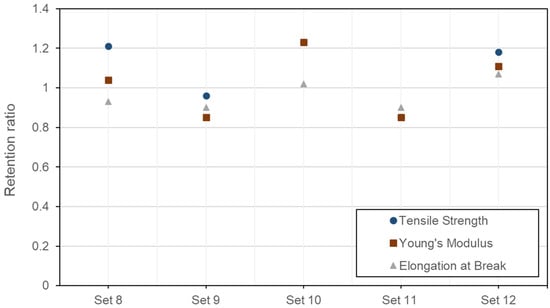
Figure 10.
Retention ratio for tensile strength, Young’s modulus, and elongation at break of 3K recycled sets.
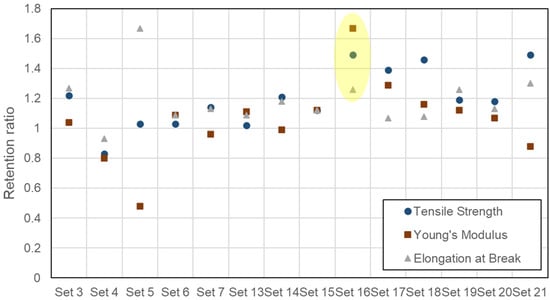
Figure 11.
Retention ratio for tensile strength, Young’s modulus, and elongation at break of 24K recycled sets (the yellow shading identifies Set 16, which exhibited the optimal mechanical performance.
3.4. Weibull Analysis
To further evaluate the reliability of the tensile strength data, a two-parameter Weibull analysis was conducted for each set. The resulting scale and shape parameters are presented in Table 3. Results demonstrated that virgin fibers exhibited one of the highest shape parameters, indicating lower variability. Among recycled sets, variations in Weibull parameters reflected the effects of residual surface defects, particularly due to uneven matrix removal. In some cases, the rCFs exceeded the performance of the virgin ones, suggesting that certain solvolysis conditions can preserve mechanical integrity. The relative standard errors of the Weibull parameters obtained from the regression analysis were below 6% for the shape factor, while the scale factor exhibited larger variability, consistent with the natural scatter of single-fiber strength data.

Table 3.
Weibull distribution parameters for tensile strength of 3K and 24K recycled carbon fiber sets.
To complement the numerical Weibull parameters presented in Table 3, Figure 12 and Figure 13 show the linearized Weibull plots for tensile strength of selected fiber sets. Figure 12 compares the virgin 3K fibers with the best-performing recycled 3K set, based on the Weibull parameters, while Figure 13 shows the corresponding comparison for the 24K fibers. Among the recycled samples, Set 16 is considered the best-performing set in terms of mechanical properties, exhibiting both the highest scale and shape factors. In addition, Set 21 demonstrated a good balance between the two Weibull parameters, indicating strong consistency and strength retention.
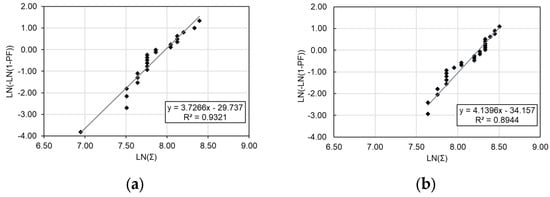
Figure 12.
Weibull function plot for the tensile strength of virgin and recycled 3K carbon fibers: (a) virgin fibers; (b) best-performing recycled set based on Weibull parameters.
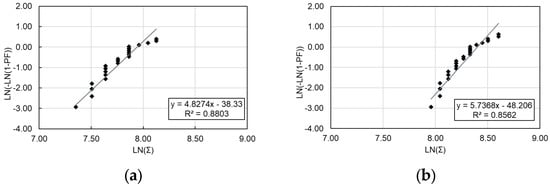
Figure 13.
Weibull function plot for the tensile strength of virgin and recycled 24K carbon fibers: (a) virgin fibers; (b) best-performing recycled set based on Weibull parameters.
3.5. Interfacial Shear Strength
IFSS was assessed for both the virgin and some of the recycled carbon fibers using the microbond test. As expected, the virgin fibers consistently exhibited higher IFSS values compared to the recycled sets, owing to their unharmed surface and optimized sizing. The interfacial shear strength of the virgin 3K fibers was 53.7 MPa. Among the rCFs, the 3K sets generally retained a high proportion of their original IFSS, with some showing only a moderate reduction. The most significant drop was observed for Set 8, which decreased by 26%. For the 24K fibers, the IFSS of the virgin fibers was 51.7 MPa and the decrease ranged from 27% to 13%. Figure 14a presents the results for the 3K fibers, while Figure 14b displays those for the 24K fibers.
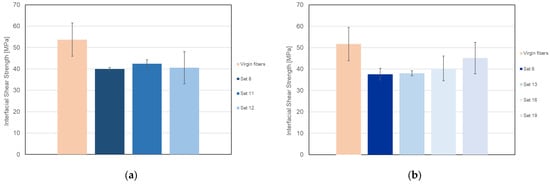
Figure 14.
IFSS results: (a) Recycled 3K carbon fibers; (b) recycled 24K carbon fibers.
The observed reduction in IFSS of the recycled fibers can also be attributed to the absence of sizing, which is removed during the solvolysis process. Sizing plays a critical role in promoting fiber/matrix adhesion by enhancing surface energy, wettability, and interfacial chemical interactions. Several studies have demonstrated that appropriate sizing agents, particularly epoxy- or polymer-based ones, can significantly increase the IFSS and fracture toughness of CFRPs by improving stress transfer across the interface []. This lack of systematic correlation indicates that IFSS is governed by multiple competing mechanisms, including sizing removal, surface oxidation, fiber surface morphology changes, and post-treatment washing effects. The literature confirms that interfacial properties are highly sensitive to sizing presence and surface chemistry: Yang et al. demonstrated that sizing agents fundamentally control surface energy and contact-angle properties critical for fiber–matrix adhesion [], while Xiao et al. reported that plasma-induced surface modifications create competing effects—enhanced oxidation versus sizing removal—that prevent monotonic IFSS trends []. The observed results suggest that future optimization of interfacial properties will require targeted experiments isolating individual variables and advanced surface characterization (e.g., XPS, AFM) to elucidate the dominant mechanisms governing IFSS retention in recycled fibers.
4. Discussion
Plasma-assisted solvolysis integrates plasma treatment with chemical depolymerization, enabling efficient matrix removal from CFRPs within a closed-loop system. Plasma-assisted solvolysis enables efficient carbon fiber recovery from CFRPs while implementing environmental controls through NOx emission capture and chemical reusability. During the process, NOx byproducts are captured in a two-stage wet scrubbing system. The scrubbing solution is later used in (a) the pre-treatment step, (b) the regeneration of the plasma reactor’s solution. The regenerated reactor liquid maintains reactivity for four consecutive operation cycles.
Different properties responded differently. The tensile strength of most recycled fibers was well retained, with several sets showing comparable or even improved values relative to virgin fibers, demonstrating that plasma-assisted solvolysis can preserve structural integrity under certain conditions. In particular, strength was robust under moderate plasma power (800–1200 W), combined with balanced acid concentrations (10–12 M) and lower composite-to-acid ratios (2.1–2.3 g/mol). Compared with data summarized from solvolysis recycling studies of CFRPs [], where recovered fibers generally retained 80–95% of their original strength, the best-performing conditions in this work achieved equal or superior retention, indicating more effective preservation of fiber integrity.
Young’s modulus exhibited greater variability, leading to both reductions and notable increases in some cases. The modulus benefited from a 12 M acid concentration and 2.3 g/mol ratio. It is worth noting that virgin 3K and 24K fibers exhibited nearly identical properties, with only a slight difference in Young’s modulus. Although the sizing was effectively removed, the observed improvements in stiffness could be partially explained by increased oxygen content and the formation of new surface functional groups, factors previously reported to influence modulus, depending on fiber type and treatment conditions [].
Elongation at break generally increased, particularly in 24K fiber sets, suggesting greater surface ductility due to microstructural smoothing during treatment.
These observations also highlight the importance of surface condition in maintaining interfacial performance, with the 3K recycled fibers showing consistency and retention of IFSS values. Overall, IFSS remained relatively insensitive to processing variations.
Weibull analysis confirmed that sets with higher shape factors exhibited more consistent mechanical behavior across recycled batches. However, input power resulted in lower Weibull shape factors, indicating more scatter and reduced reliability. This observed scatter in lower-performing batches may be linked to morphological inconsistencies, such as fiber twisting or localized degradation from plasma exposure.
In a potential next phase, a multi-objective optimization approach could be employed to identify process conditions that balance all the tensile properties. Based on the existing mechanical dataset, a model may be developed to simultaneously maximize performance, constrained within experimentally validated parameter ranges to ensure feasibility. The predicted optimal parameters could then guide future solvolysis trials to support model validation.
5. Conclusions
The findings of this study demonstrate the environmental, mechanical, and operational advantages of plasma-assisted solvolysis process for carbon fiber recovery. The main conclusions are summarized below:
- Moderate plasma power (800–1200 W), a mixed N2/Ar atmosphere, and balanced acid concentration (10–12 M) yielded the most favorable mechanical properties, maintaining or exceeding the tensile strength of virgin fibers while ensuring acceptable interfacial performance;
- The optimal recycling outcome, in terms of the mechanical properties, was achieved under conditions corresponding to four plasma heads, 800 W plasma power, an N2/Ar gas mixture (0.12/0.48 L min−1), and 12 M nitric acid concentration;
- Although demonstrated only at laboratory scale, the process’s moderate energy demand and potential for acid recovery indicate promising scalability for sustainable composite recycling.
Author Contributions
Conceptualization, I.T., K.T., D.M., E.F. and E.A.; methodology, I.T. and K.T.; validation, I.T., K.T., D.M., E.F. and E.A.; formal analysis, I.T. and K.T.; investigation, I.T., K.T., D.M., E.F. and E.A.; resources, I.T., K.T., D.M., E.F. and E.A.; data curation, I.T., K.T., D.M., E.F. and E.A.; writing—original draft preparation, I.T.; writing—review and editing, K.T.; visualization, I.T.; supervision, K.T.; project administration, K.T. and E.A.; funding acquisition, K.T., E.F. and E.A. All authors have read and agreed to the published version of the manuscript.
Funding
This research was implemented in the framework of H.F.R.I. called “Basic research Financing (Horizontal support of all Sciences)” under the National Recovery and Resilience Plan “Greece 2.0” funded by the European Union—NextGenerationEU (H.F.R.I. Project Number: 15231).
Data Availability Statement
All data are presented in the manuscript.
Acknowledgments
The authors would like to thank the Laboratory of Biomechanics and Biomedical Engineering of the University of Patras for helping and providing access to the Miniature Materials Tester Minimat 2000, and B&T Composites, Florina, Greece for providing the composites.
Conflicts of Interest
The authors declare no conflicts of interest.
Appendix A. Summary of Mechanical Test Data
The following tables summarize the mechanical characterization results of the recycled carbon fiber sets. Each value represents the mean ± standard deviation obtained from at least 25 valid single-fiber tensile tests per set. Data is presented separately for the 3K (Table A1) and 24K fiber tows (Table A2). Results include tensile strength, Young’s modulus, and elongation at break.

Table A1.
Mechanical properties of recycled 3K carbon fibers.
Table A1.
Mechanical properties of recycled 3K carbon fibers.
| Set | Tensile Strength (MPa) | Young’s Modulus (GPa) | Elongation at Break (%) |
|---|---|---|---|
| Virgin | 2264.33 ± 905.87 | 151.06 ± 49.47 | 2.09 ± 0.59 |
| Set 8 | 2793.33 ± 1031.58 | 293.23 ± 161.00 | 1.69 ± 0.25 |
| Set 9 | 2745.28 ± 927.58 | 208.77 ± 76.90 | 1.45 ± 0.47 |
| Set 10 | 1915.58 ± 653.57 | 186.96 ± 55.58 | 1.40 ± 0.47 |
| Set 11 | 2708.35 ± 1295.04 | 219.16 ± 61.50 | 1.70 ± 0.54 |
| Set 12 | 4465.82 ± 640.81 | 201.59 ± 40.89 | 1.56 ± 0.33 |

Table A2.
Mechanical properties of recycled 24K carbon fibers.
Table A2.
Mechanical properties of recycled 24K carbon fibers.
| Set | Tensile Strength (MPa) | Young’s Modulus (GPa) | Elongation at Break (%) |
|---|---|---|---|
| Virgin | 2632.31 ± 815.34 | 151.06 ± 49.47 | 2.09 ± 0.59 |
| Set 3 | 2172.27 ± 644.06 | 202.33 ± 62.63 | 1.50 ± 0.40 |
| Set 4 | 2988.18 ± 740.03 | 228.15 ± 48.19 | 1.88 ± 0.37 |
| Set 5 | 3211.68 ± 1033.63 | 247.79 ± 95.17 | 2.10 ± 0.62 |
| Set 6 | 2172.27 ± 1273.80 | 190.10 ± 47.43 | 1.55 ± 0.41 |
| Set 7 | 2632.31 ± 815.34 | 238.89 ± 97.38 | 1.66 ± 0.37 |
| Set 13 | 3928.85 ± 743.78 | 223.08 ± 48.53 | 1.67 ± 0.23 |
| Set 14 | 2693.73 ± 726.94 | 224.01 ± 44.92 | 1.70 ± 0.37 |
| Set 15 | 2941.44 ± 1057.41 | 268.40 ± 140.58 | 1.86 ± 0.48 |
| Set 16 | 2671.21 ± 573.82 | 223.08 ± 48.53 | 1.67 ± 0.23 |
| Set 17 | 3294.83 ± 1129.45 | 277.74 ± 98.08 | 1.79 ± 0.33 |
| Set 18 | 3193.89 ± 722.86 | 256.22 ± 77.69 | 1.88 ± 0.31 |
| Set 19 | 3145.02 ± 722.86 | 237.18 ± 51.05 | 1.96 ± 0.35 |
| Set 20 | 3116.88 ± 613.74 | 225.92 ± 52.12 | 1.96 ± 0.34 |
| Set 21 | 3377.98 ± 905.88 | 210.47 ± 48.75 | 2.15 ± 0.33 |
Appendix B. Summary of IQR Filtering
The interquartile range (IQR) method was applied to identify and exclude statistical outliers from the single-fiber tensile test datasets. The acceptable interval was defined as , where and are the first and third quartiles of each dataset. Values outside this interval were treated as outliers and omitted before calculating the average and standard deviation. To assess the precision of the averages, 95% confidence intervals (CI) were calculated using Student’s t-distribution for each set, according to:
Table A3 and Table A4 summarize, for each experimental set, the number of tested fibers, outliers removed, excluded percentage, and corresponding 95% CI for tensile strength.

Table A3.
Summary of statistical filtering for 3K fibers, showing the tested specimens, outliers removed through the IQR criterion, percentage of rejected data, and 95% confidence interval for the tensile strength mean.
Table A3.
Summary of statistical filtering for 3K fibers, showing the tested specimens, outliers removed through the IQR criterion, percentage of rejected data, and 95% confidence interval for the tensile strength mean.
| Set | Fibers Tested | Outliers | Excluded (%) | ±95% CI (MPa) |
|---|---|---|---|---|
| Virgin | 30 | 7 | 23.3 | 336 |
| Set 8 | 27 | 3 | 11.1 | 644 |
| Set 9 | 30 | 4 | 13.3 | 362 |
| Set 10 | 29 | 3 | 10.3 | 257 |
| Set 11 | 27 | 5 | 18.5 | 502 |
| Set 12 | 27 | 2 | 7.4 | 255 |

Table A4.
Summary of statistical filtering for 24K fibers, showing the tested specimens, outliers removed through the IQR criterion, percentage of rejected data, and 95% confidence interval for the tensile strength mean.
Table A4.
Summary of statistical filtering for 24K fibers, showing the tested specimens, outliers removed through the IQR criterion, percentage of rejected data, and 95% confidence interval for the tensile strength mean.
| Set | Fibers Tested | Outliers | Excluded (%) | ±95% CI (MPa) |
|---|---|---|---|---|
| Virgin | 25 | 2 | 8.0 | 337 |
| Set 3 | 29 | 1 | 3.4 | 247 |
| Set 4 | 30 | 4 | 13.3 | 279 |
| Set 5 | 25 | 0 | 0.0 | 426 |
| Set 6 | 32 | 3 | 9.4 | 472 |
| Set 7 | 30 | 2 | 6.7 | 306 |
| Set 14 | 28 | 3 | 10.7 | 283 |
| Set 15 | 31 | 4 | 12.9 | 392 |
| Set 16 | 31 | 6 | 19.4 | 203 |
| Set 17 | 28 | 5 | 17.9 | 441 |
| Set 18 | 29 | 2 | 6.9 | 276 |
| Set 19 | 30 | 1 | 3.3 | 274 |
| Set 20 | 30 | 4 | 13.3 | 243 |
| Set 21 | 29 | 2 | 6.9 | 347 |
References
- Recent Developments in the Synthesis of Composite Materials for Aerospace: Case Study—MedCrave Online. Available online: https://medcraveonline.com/MSEIJ/recent-developments-in-the-synthesis-of-composite-materials-for-aerospace-case-study.html (accessed on 26 June 2025).
- Zhang, J.; Lin, G.; Vaidya, U.; Wang, H. Past, Present and Future Prospective of Global Carbon Fibre Composite Developments and Applications. Compos. Part B Eng. 2023, 250, 110463. [Google Scholar] [CrossRef]
- Basri, M.H. Application of Carbon Fiber Reinforced Plastics in Automotive Industry: A Review. Technical Report. 2018. Available online: https://www.researchgate.net/publication/337917403 (accessed on 9 November 2025).
- High Performance Composites Market Size to Hit USD 159.35 Bn by 2034. Available online: https://www.precedenceresearch.com/high-performance-composites-market (accessed on 26 June 2025).
- Composite Waste: Understanding Regulations and Finding Circular Solutions for a Growing Problem. Available online: https://www.circularise.com/blogs/composite-waste-understanding-regulations-and-finding-circular-solutions-for-a-growing-problem (accessed on 8 July 2025).
- Anagnostopoulou, A.; Sotiropoulos, D.; Tserpes, K. A Robust Sustainability Assessment Methodology for Aircraft Parts: Application to a Fuselage Panel. Sustainability 2025, 17, 3299. [Google Scholar] [CrossRef]
- Vogiantzi, C.; Tserpes, K. On the Definition, Assessment, and Enhancement of Circular Economy across Various Industrial Sectors: A Literature Review and Recent Findings. Sustainability 2023, 15, 16532. [Google Scholar] [CrossRef]
- Morici, E.; Dintcheva, N.T. Recycling of Thermoset Materials and Thermoset-Based Composites: Challenge and Opportunity. Polymers 2022, 14, 4153. [Google Scholar] [CrossRef] [PubMed]
- Aldosari, S.M.; AlOtaibi, B.M.; Alblalaihid, K.S.; Aldoihi, S.A.; AlOgab, K.A.; Alsaleh, S.S.; Alshamary, D.O.; Alanazi, T.H.; Aldrees, S.D.; Alshammari, B.A. Mechanical Recycling of Carbon Fiber-Reinforced Polymer in a Circular Economy. Polymers 2024, 16, 1363. [Google Scholar] [CrossRef]
- Qureshi, J. A Review of Recycling Methods for Fibre Reinforced Polymer Composites. Sustainability 2022, 14, 16855. [Google Scholar] [CrossRef]
- Ateeq, M. A State of Art Review on Recycling and Remanufacturing of the Carbon Fiber from Carbon Fiber Polymer Composite. Compos. Part C Open Access 2023, 12, 100412. [Google Scholar] [CrossRef]
- Ventura, A.M.; Kneissl, L.M.; Nunes, S.; Emami, N. Recycled Carbon Fibers as an Alternative Reinforcement in UHMWPE Composite. Circular Economy within Polymer Tribology. Sustain. Mater. Technol. 2022, 34, e00510. [Google Scholar] [CrossRef]
- Ren, Y.; Xu, L.; Shang, X.; Shen, Z.; Fu, R.; Li, W.; Guo, L. Evaluation of Mechanical Properties and Pyrolysis Products of Carbon Fibers Recycled by Microwave Pyrolysis. ACS Omega 2022, 7, 13529–13537. [Google Scholar] [CrossRef]
- Alguacil, M.C.; Umeki, K.; You, S.; Joffe, R. Evolution of Carbon Fiber Properties during Repetitive Recycling via Pyrolysis and Partial Oxidation. Carbon Trends 2025, 18, 100438. [Google Scholar] [CrossRef]
- Charitidis, J. Panagiotis Recycling of Carbon Fiber-Reinforced Composites—A Review. Int. J. Adv. Res. Sci. Commun. Technol. 2024, 4, 431–445. [Google Scholar] [CrossRef]
- Zhang, X.; Sibari, R.; Chakraborty, S.; Baz, S.; Gresser, G.T.; Benner, W.; Brämer, T.; Steuernagel, L.; Ionescu, E.; Deubener, J.; et al. Epoxy–Based Carbon Fiber–Reinforced Plastics Recycling via Solvolysis with Non–Oxidizing Methanesulfonic Acid. Chem. Ing. Tech. 2024, 96, 987–997. [Google Scholar] [CrossRef]
- Das, M.; Chacko, R.; Varughese, S. An Efficient Method of Recycling of CFRP Waste Using Peracetic Acid. ACS Sustain. Chem. Eng. 2018, 6, 1564–1571. [Google Scholar] [CrossRef]
- Torkaman, N.F.; Bremser, W.; Wilhelm, R. Catalytic Recycling of Thermoset Carbon Fiber-Reinforced Polymers. ACS Sustain. Chem. Eng. 2024, 12, 7668–7682. [Google Scholar] [CrossRef]
- Sakai, A.; Kurniawan, W.; Kubouchi, M. Chemical Recycling of CFRP in an Environmentally Friendly Approach. Polymers 2024, 16, 143. [Google Scholar] [CrossRef]
- Jeong, J.; Oh, D.; Ju, Y.; Goh, M. Energy-Efficient Chemical Recycling of CFRP and Analysis of the Interfacial Shear Strength on Recovered Carbon Fiber. Waste Manag. 2024, 187, 134–144. [Google Scholar] [CrossRef]
- Zhao, Q.; An, L.; Li, C.; Zhang, L.; Jiang, J.; Li, Y. Environment-Friendly Recycling of CFRP Composites via Gentle Solvent System at Atmospheric Pressure. Compos. Sci. Technol. 2022, 224, 109461. [Google Scholar] [CrossRef]
- Patre, R.; Rani, M.; Zafar, S. Insights into Environmental Sustainability of Microwave Assisted Chemical Recycling of CFRP Waste Using Life Cycle Assessment. Waste Manag. Bull. 2025, 3, 100194. [Google Scholar] [CrossRef]
- Henry, L.; Schneller, A.; Doerfler, J.; Mueller, W.M.; Aymonier, C.; Horn, S. Semi-Continuous Flow Recycling Method for Carbon Fibre Reinforced Thermoset Polymers by near- and Supercritical Solvolysis. Polym. Degrad. Stab. 2016, 133, 264–274. [Google Scholar] [CrossRef]
- Jiang, G.; Pickering, S.; Lester, E.; Turner, T.; Wong, K.; Warrior, N. Characterisation of Carbon Fibres Recycled from Carbon Fibre/Epoxy Resin Composites Using Supercritical n-Propanol. Compos. Sci. Technol. 2009, 69, 192–198. [Google Scholar] [CrossRef]
- Xu, P.; Li, J.; Ding, J. Chemical Recycling of Carbon Fibre/Epoxy Composites in a Mixed Solution of Peroxide Hydrogen and N,N-Dimethylformamide. Compos. Sci. Technol. 2013, 82, 54–59. [Google Scholar] [CrossRef]
- Pei, C.; Chen, P.; Kong, S.-C.; Wu, J.; Zhu, J.-H.; Xing, F. Recyclable Separation and Recovery of Carbon Fibers from CFRP Composites: Optimization and Mechanism. Sep. Purif. Technol. 2021, 278, 119591. [Google Scholar] [CrossRef]
- Yan, H.; Lu, C.; Jing, D.; Chang, C.; Liu, N.; Hou, X. Recycling of Carbon Fibers in Epoxy Resin Composites Using Supercritical 1-Propanol. New Carbon Mater. 2016, 31, 46–54. [Google Scholar] [CrossRef]
- Cai, G.; Yin, G.; Wada, M.; Kitaoka, S.; Wei, H.; Ohsawa, I.; Takahashi, J. Influence of Recycling Process on the Tensile Property of Carbon Fiber. In Proceedings of the 21st International Conference on Composite Materials, Xi’an, China, 20–25 August 2017. [Google Scholar]
- Sokoli, H.U.; Beauson, J.; Simonsen, M.E.; Fraisse, A.; Brøndsted, P.; Søgaard, E.G. Optimized Process for Recovery of Glass- and Carbon Fibers with Retained Mechanical Properties by Means of near- and Supercritical Fluids. J. Supercrit. Fluids 2017, 124, 80–89. [Google Scholar] [CrossRef]
- Vogiantzi, C.; Tserpes, K. A Preliminary Investigation on a Water- and Acetone-Based Solvolysis Recycling Process for CFRPs. Materials 2024, 17, 1102. [Google Scholar] [CrossRef]
- Vogiantzi, C.; Tserpes, K. Mechanical Properties of Carbon Fibers and Fiber/Matrix Interface Recycled from CFRPs via Water/Ethanol-Based Solvolysis under Various Processing Conditions. Eur. J. Mater. 2025, 5, 2571803. [Google Scholar] [CrossRef]
- Das, M.; Varughese, S. A Novel Sonochemical Approach for Enhanced Recovery of Carbon Fiber from CFRP Waste Using Mild Acid–Peroxide Mixture. ACS Sustain. Chem. Eng. 2016, 4, 2080–2087. [Google Scholar] [CrossRef]
- Bruggeman, P.J.; Kushner, M.J.; Locke, B.R.; Gardeniers, J.G.E.; Graham, W.G.; Graves, D.B.; Hofman-Caris, R.C.H.M.; Maric, D.; Reid, J.P.; Ceriani, E.; et al. Plasma–Liquid Interactions: A Review and Roadmap. Plasma Sources Sci. Technol. 2016, 25, 53002. [Google Scholar] [CrossRef]
- Marinis, D.; Farsari, E.; Alexandridou, C.; Amanatides, E.; Mataras, D. Chemical Recovery of Carbon Fibers from Composites via Plasma Assisted Solvolysis. J. Phys. Conf. Ser. 2024, 2692, 12017. [Google Scholar] [CrossRef]
- Marinis, D.; Farsari, E.; Amanatides, E. Dissolution Kinetics in Plasma-Enhanced Nitric Acid Solvolysis of CFRCs. Materials 2025, 18, 4242. [Google Scholar] [CrossRef]
- Fibermax Ltd. Carbon Fiber Tow 3Κ, 1.80 kg, 5 km. Available online: https://www.fibermax.eu/el-gr/anthrakoyfasmata/nimata/nimata-provoli-olon/desmi-anthrakonimaton-3k-1-kg-5-km.html (accessed on 26 June 2025).
- SR 1700—System for Manufacturing Composite Structures; Sicomin: Chateauneuf les Martigues, France, 2015.
- Marinis, D.; Markatos, D.; Farsari, E.; Amanatides, E.; Mataras, D.; Pantelakis, S. A Novel Plasma-Enhanced Solvolysis as Alternative for Recycling Composites. Polymers 2024, 16, 2836. [Google Scholar] [CrossRef]
- C28 Committee ASTM International. Test Method for Tensile Strength and Youngs Modulus of Fibers; ASTM International: West Conshohocken, PA, USA, 2020. [Google Scholar] [CrossRef]
- Laurikainen, P.; Kakkonen, M.; Von Essen, M.; Tanhuanpää, O.; Kallio, P.; Sarlin, E. Identification and Compensation of Error Sources in the Microbond Test Utilising a Reliable High-Throughput Device. Compos. Part A Appl. Sci. Manuf. 2020, 137, 105988. [Google Scholar] [CrossRef]
- Borkar, A.; Hendlmeier, A.; Simon, Z.; Randall, J.D.; Stojcevski, F.; Henderson, L.C. A Comparison of Mechanical Properties of Recycled High–density Polyethylene/Waste Carbon Fiber via Injection Molding and 3D Printing. Polym. Compos. 2022, 43, 2408–2418. [Google Scholar] [CrossRef]
- Rahimizadeh, A.; Tahir, M.; Fayazbakhsh, K.; Lessard, L. Tensile Properties and Interfacial Shear Strength of Recycled Fibers from Wind Turbine Waste. Compos. Part A Appl. Sci. Manuf. 2020, 131, 105786. [Google Scholar] [CrossRef]
- Cai, G.; Wada, M.; Ohsawa, I.; Kitaoka, S.; Takahashi, J. Influence of Treatment with Superheated Steam on Tensile Properties of Carbon Fiber. Compos. Part A Appl. Sci. Manuf. 2018, 107, 555–560. [Google Scholar] [CrossRef]
- Kim, G.; Lee, H.; Kim, M.; Kim, D.U. Investigating the Effects of Nitric Acid Treatments on the Properties of Recycled Carbon Fiber. Polymers 2023, 15, 824. [Google Scholar] [CrossRef] [PubMed]
- Rijo, B.; Dias, A.P.S.; Carvalho, J.P.S. Recovery of Carbon Fibers from Aviation Epoxy Composites by Acid Solvolysis. Sustain. Mater. Technol. 2023, 35, e00545. [Google Scholar] [CrossRef]
- Marinis, D.; Tourkantoni, I.; Farsari, E.; Amanatides, E.; Tserpes, K. Effect of Process Parameters on Plasma-Enhanced Solvolysis of CFRPs. Materials 2025, 18, 5081. [Google Scholar] [CrossRef]
- Roseno, S.; Ammarullah, M.I.; Rohman, S.; Kurniawati, F.; Wahyudi, T.; Wargadipura, A.H.S.; Masmui, M.; Budiyanto, D.; Effendi, M.D.; Wahyudin, W.; et al. The Effects of Carbon Fiber Surface Treatment by Oxidation Process for Enhanced Mechanical Properties of Carbon Fiber/Epoxy Composites for Biomedical Application. AIP Adv. 2024, 14, 15044. [Google Scholar] [CrossRef]
- Langston, T.A.; Granata, R.D. Influence of Nitric Acid Treatment Time on the Mechanical and Surface Properties of High-Strength Carbon Fibers. J. Compos. Mater. 2014, 48, 259–276. [Google Scholar] [CrossRef]
- Ahmed, K.; Qin, X.; Pang, Y.; Shao, Y.; Islam, S.R.; Yang, Y.; Hamada, H.; Yu, L. Effect of De-Sizing on the Structural and Mechanical Properties of Carbon Fiber Reinforced Polypropylene Composites Molded by the Novel Direct Fiber Feeding Injection Molding Technology. J. Thermoplast. Compos. Mater. 2023, 36, 1847–1876. [Google Scholar] [CrossRef]
- He, D.; Soo, V.K.; Stojcevski, F.; Lipiński, W.; Henderson, L.C.; Compston, P.; Doolan, M. The Effect of Sizing and Surface Oxidation on the Surface Properties and Tensile Behaviour of Recycled Carbon Fibre: An End-of-Life Perspective. Compos. Part A Appl. Sci. Manuf. 2020, 138, 106072. [Google Scholar] [CrossRef]
- Semitekolos, D.; Terzopoulou, S.; Zecchi, S.; Marinis, D.; Farsari, E.; Amanatides, E.; Sajdak, M.; Sobek, S.; Smok, W.; Tański, T.; et al. Performance Restoration of Chemically Recycled Carbon Fibres Through Surface Modification with Sizing. Polymers 2024, 17, 33. [Google Scholar] [CrossRef] [PubMed]
- Joo, J.-H.; Kim, S.-H.; Yim, Y.-J.; Bae, J.-S.; Seo, M.-K. Interfacial Interlocking of Carbon Fiber-Reinforced Polymer Composites: A Short Review. Polymers 2025, 17, 267. [Google Scholar] [CrossRef] [PubMed]
- Yang, T.; Zhao, Y.; Liu, H.; Sun, M.; Xiong, S. Effect of Sizing Agents on Surface Properties of Carbon Fibers and Interfacial Adhesion of Carbon Fiber/Bismaleimide Composites. ACS Omega 2021, 6, 23028–23037. [Google Scholar] [CrossRef]
- Xiao, J.; Tian, S.; Zhou, H.; Gao, A.; Xu, L. Construction of Polar Functional Groups on the Surface of a High-Modulus Carbon Fiber and Its Effect on the Interfacial Properties of Composites. ACS Omega 2023, 8, 29262–29269. [Google Scholar] [CrossRef]
- Butenegro, J.A.; Bahrami, M.; Abenojar, J.; Martínez, M.Á. Recent Progress in Carbon Fiber Reinforced Polymers Recycling: A Review of Recycling Methods and Reuse of Carbon Fibers. Materials 2021, 14, 6401. [Google Scholar] [CrossRef]
- Sakai, A.; Kurniawan, W.; Kubouchi, M. Recycled Carbon Fibers with Improved Physical Properties Recovered from CFRP by Nitric Acid. Appl. Sci. 2023, 13, 3957. [Google Scholar] [CrossRef]
Disclaimer/Publisher’s Note: The statements, opinions and data contained in all publications are solely those of the individual author(s) and contributor(s) and not of MDPI and/or the editor(s). MDPI and/or the editor(s) disclaim responsibility for any injury to people or property resulting from any ideas, methods, instructions or products referred to in the content. |
© 2025 by the authors. Licensee MDPI, Basel, Switzerland. This article is an open access article distributed under the terms and conditions of the Creative Commons Attribution (CC BY) license (https://creativecommons.org/licenses/by/4.0/).